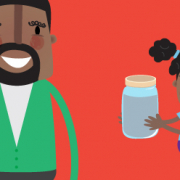The purpose of Christmas is to remember Jesus’ birth, so why not celebrate it outside the traditional season? Most children love Christmas and would not object to some Christmas festivities being added to the family schedule any time of year! The ideas provided here focus on the joy surrounding the birth of Jesus and on the enjoyment found in giving. Whichever activity you choose, you can use the discussion questions and related Bible verses to highlight the “Christmas-Jesus-Joy” connection.
Serving others
Organize a stocking stuffing event as a way to have family members bless each other with non-material blessings. Have each family member hang a mini-stocking. Put each person’s picture on their stocking, then have each family member write a note or draw a picture for every other family member, telling or displaying something they appreciate about them. Encourage your kids to be creative and provide assistance as needed. When you open the stockings, do so one person at a time, allowing time for each person to share what the other family members have written or drawn. To make the occasion even sweeter, you may want to hand out candy canes (or flavoured hard candy sticks) to savour while you enjoy the sweetness of your together time.
Fun with food
Make mini-gingerbread “stables” out of graham crackers. Use one cracker for each side wall, one for the roof and one for a back wall. Leave the front side open. While your kids are decorating the walls and interior, ask your kids what they think Jesus was like when He was a child. Have them think of a “Jesus-like” character trait that each type of candy, cereal or dried fruit can represent. For example, cinnamon hearts can serve as a reminder that there is joy in a home when family members are loving toward each other. Another child might say that a gummy blue whale reminds him to be generous and share his toys.
To make the icing for your gingerbread stables, you will need:
2 egg whites
1 tsp vanilla or peppermint extract
2 ½ – 3 cups of icing sugar
Use a hand mixer to beat the egg whites until they are fluffy. Add the flavouring, along with half a cup of powdered sugar. Beat the mixture until it’s smooth. Keep adding icing sugar, half a cup at a time, until the icing forms stiff peaks. This icing is ideal for decorating as it hardens quickly. If you are not going to use it right away, cover it tightly with plastic wrap and refrigerate it.
Serving others
To allow your children to experience the joy of giving, plan to surprise someone with a gift of some Christmas baking, out of season. Prior to deciding who you should share your baking with, ask God which family friend, relative or neighbour is in need of extra encouragement. Use the experience as an opportunity to talk with your children about how joyful they feel when they bless another person with a gift. Compare this to the joy they feel when they receive gifts.
Nativity drama
Set up a Nativity scene and have your children act out the Christmas story while you read it aloud. Household items like brooms, towels and bathrobes can serve as props and the cast’s wardrobe. As you read the Christmas story, let your kids play a variety of roles using props of their choice. For example, they might choose a mop to be a donkey, a laundry basket as a manger and a tissue box as a wise man’s gift.
Creative crafts
If your children enjoy crafts, have them make a “baby Jesus in a manger ornament.” As they work, use the opportunity to discuss the joy of the first Christmas. Share with your children the angel’s announcement to the shepherds, “Do not be afraid. I bring you good news that will cause great joy for all the people” (Luke 2:10). Remind your kids that through Jesus, God gave the whole world the gift of salvation.
To make one manger ornament, you will need:
a circular mini-grape vine wreath (6-8 cm or 2½ – 3 inches in diameter)
a wooden bead (1.5 cm or ½ inch in diameter)
strips of cloth (cut from an old tea towel)
cardboard
a piece of string or ribbon
an ice pop stick
straw of any sort
felt markers
a low-temperature glue gun
- Begin by gluing a layer of brown cardboard on the bottom of the grapevine wreath to create a manger. Spread a layer of glue in the bottom of the manger and have your child fill it with craft moss, shredded yellow paper or tissue, yellow yarn or Easter basket grass, making a cozy manger.
- To make baby Jesus, draw closed eyes and a little mouth on the wooden bead. Glue one-third of an ice pop stick to the back of the bead to serve as a “body,” then have your child wrap strips of cloth around and around the stick until it looks like a wrapped-up baby. Secure the end of the cloth with a spot of glue.
- Glue another smaller strip of cloth over the baby’s head to cover the bead hole.
- Finally, glue the baby in the manger and tie a ribbon to the top of the wreath so you can hang it up.
Note: This baby Jesus ornament can also be used in the shadow box for the kick-off craft of this lesson.
Drive time
While you are travelling in your family’s vehicle, sing Joy to the World and talk about ways that Jesus brings joy to your lives. Put your ideas into song with your own Jesus-centred remake of The Twelve Days of Christmas. Here’s a sample to jump-start your own ideas:
On the first day of Christmas, Jesus gave to me, His Spirit to live in me.
On the second day of Christmas, Jesus gave to me, two helping hands…
On the third day of Christmas, Jesus gave to me, three cups of kindness…
On the fourth day of Christmas, Jesus gave to me, four jugs of joy…
On the fifth day of Christmas, Jesus gave to me, five reasons to share…
On the sixth day of Christmas, Jesus gave to me, six packs of peace…
On the seventh day of Christmas, Jesus gave to me, seven sacks of smiles…
On the eighth day of Christmas, Jesus gave to me, eight gobs of goodness…
On the ninth day of Christmas, Jesus gave to me, nine loads of love…
On the tenth day of Christmas, Jesus gave to me, ten tons of trust…
On the eleventh day of Christmas, Jesus gave to me, eleven pounds of patience…
On the twelfth day of Christmas, Jesus gave to me, twelve jars of gentleness…
Questions for discussion
- What is your most favourite Christmas tradition of all?
- If you could play a part in the Christmas story, which character would you like to be?
- What do you think it would have been like to have Jesus as a brother?
- How does Jesus bring joy to your life?
- How does knowing Jesus change the way you treat others?
Relevant Scripture
Acts 20:35 “In everything I did, I showed you that by this kind of hard work we must help the weak, remembering the words the Lord Jesus Himself said: ‘It is more blessed to give than to receive.’ ”
Luke 2:10-12 “But the angel said to them, ‘Do not be afraid. I bring you good news of great joy that will be for all the people. Today in the town of David a Savior has been born to you; He is Christ the Lord. This will be a sign to you: You will find a baby wrapped in cloths and lying in a manger.’ ”
Luke 11:13 “If you then, though you are evil, know how to give good gifts to your children, how much more will your Father in heaven give the Holy Spirit to those who ask Him!”
1 Thessalonians 5:11 “Therefore encourage one another and build each other up, just as in fact you are doing.”








 Breastplate | You will need a chest-sized piece of cardboard, scissors and 61 cm (24 inches) of fabric elastic measuring 2.5 cm (1 inch) wide, plus your choice of medium to decorate or cover the cardboard. Begin by slicing 1-cm-wide slits (half-inch slits) in the cardboard as shown below – one at each corner and one in the middle of each side.
Breastplate | You will need a chest-sized piece of cardboard, scissors and 61 cm (24 inches) of fabric elastic measuring 2.5 cm (1 inch) wide, plus your choice of medium to decorate or cover the cardboard. Begin by slicing 1-cm-wide slits (half-inch slits) in the cardboard as shown below – one at each corner and one in the middle of each side.